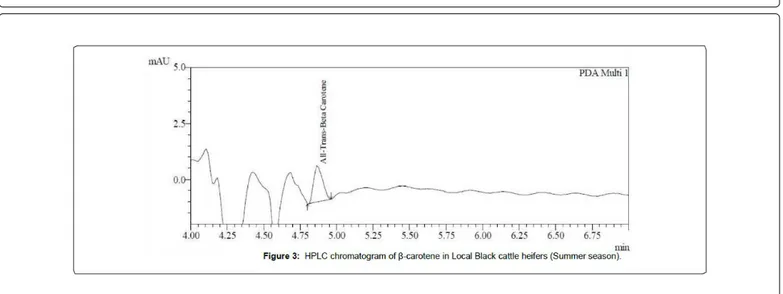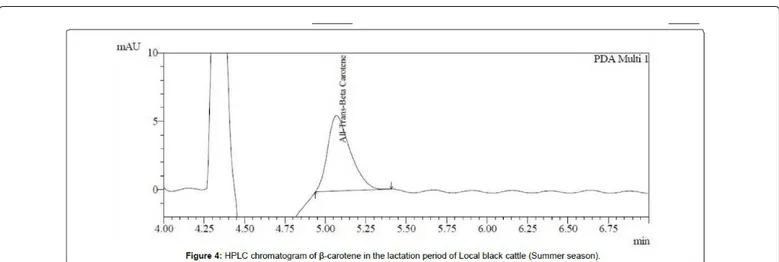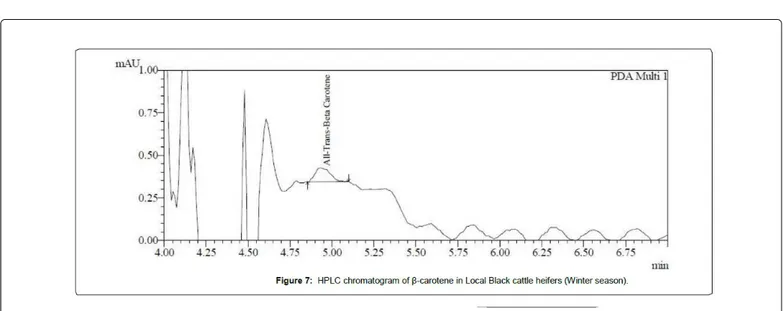Serum Β-Carotene Levels of the
Local Black Cattle in Lactation
Period, Dry Period and Different
Ages, Seasons
Bulent Bayraktar1*, Ayse Arzu Yigit2 and Husamettin Ekici3 1Faculty of Health Sciences, Department of Phsiotherapy and Rehabilitation, Bayburt Üniversity, Turkey
2Department of Physiology, Faculty of Veterinary Medicine, Kirikkale University, Turkey
3Department of Pharmacology and Toxicology, Faculty of Veterinary Medicine, Kirikkale University, Turkey
*Corresponding author: Bulent Bayraktar, Faculty of Health Sciences,
Department of Phsiotherapy and Rehabilitation, Bayburt University, Bayburt, Turkey; E-mail: bulenttbayraktar@gmail.com.tr
Received: May 29, 2018 Accepted: February 1, 2019 Published: February 6,
2019
Abstract
β-carotene in carotenoIds group is the primary Ingredient of vitamin A and is widely found in green leafy plants. Cattle provide β-Carotene by eating grass and feeds since they cannot synthesize. β-carotene deficiency causes many metabolic disorders in animals. The aim of this study was to determine the effects of season, age, lactation and dry period on β-Carotene level at Local Black Cattle whIch are only breed In AnatolIa.
This study was carrIed out in native cattle race (Local Black) that breds in our country, 80 of which belong to the protection flocks that are grown in the northern parts of Central Anatolia. The groups were arranged as group 1, 1-3 months calves (n=20); group 2, 12-24 months heIfers (n=20); group 3, 3-7 years old cattle In the fIrst 10 weeks perIod of lactation (n=20), group 4, 3-7 years old cattle In the last 2 month of pregnancy (dry perIod) (n=20). β-Carotene levels were measured from the serum samples which was obtaIned from the same anImals blood that was taken from the summer and wInter. In summer, β-carotene levels of the lactatIng cattle, heIfer and cattle In dry perIod were hIgher than wInter. Also, serum β-carotene was the hIghest In lactatIng group both summer and wInter.
As a result, our results showed that season, age, lactation and pregnancy were effective on serum β-carotene levels. Also, reference values of the Local Black were obtained.
Keywords: Age; β-Carotene; Dry period; Local breed; Lactation; Pregnancy; Season
Introduction
β-carotene is one of the most important criteria that plays a key role in the continuity of production and reproductive performance in milk
economic losses by affecting the performance parameters of the cattle, especially the reproductive efficiency. [1,2]. Therefore, It is essential that the requirements of animals are determined correctly in animal feeding. Serum β-carotene level differs according to the content of the feed, age and animal race [3].
β-carotene is a carotenoid that contains carbon (C40) and hydrogen atoms but does not contain oxygen atoms [4]. The general formula is C40H56 (FIgure 1). It belongs to the carotenoid group which is consist of isopropene units [5].
In this study, serum β-carotene levels of the local black cattle was investigated between the summer and winter in physiological conditions. Also, Its level was compared wIth the different age. AddItionally, It is thought that data may be an reference for future scientific research.
Material and Methods
Local Black cattle, which is only breeds in Anatolia, was grouped as; group 1, 1-3 month calves (n=20), group 2, 12-24 month heIfers (n=20), Group 3; 3-7 years old cattle in the first 10 weeks after birth (n=20) Group 4; 3-7 years pregnant cattle in the dry period of (n=20). Blood samples were taken from vena jugularIs. Serum samples were stored at -80 °C untIl β-carotene analysis was performed after centrifugation for 10 m in at 3000 rpm.
Serum β-carotene determination
The process of extraction was carried out according to the method advised by Schierle et al. [6], and measurements were actualized high-performance liquid chromatography (Shimadzu, Japan).
Statistical analysis
The SAS program (VersIon 8.02, Institute Inc., Cary, NC) was used for statistical analysis of the results. One Way ANOVA and Tukey were used for the comparIson of the β-carotene levels in different age. Student ’ s-t test was used for seasonal (summer and winter) comparisons within each groups. All significant differences were tested at p <0.05 level. The results were given as mean ± standard error.
Results
Method validation findings
β-carotene chromatograms from each group was given in Figures 2 to 9. According to the figures; when the average β-carotene levels in calves, heifer, lactation and dry period animals were examined, It was seen that the areas under the curve were higher in the chromatograms of the samples in summer. The principles of conformity to Turkish (summer and winter) were found to be among the different groups in which lactation was the highest in comparison of age groups of animals (p˂0,001).
The aim of this study was to determine the physiological changes of serum β-carotene levels in local black cattle, which was breed in Turkey, and to compare the effects of season, age, lactation and dry Bayraktar B, Yigit A, Ekici H, J Vet Sci Med Diagn 2019, 8:1
DOI: 10.4172/2325-9590.1000272
Journal of Veterinary
Science & Medical
Diagnosis
Figure 1: The chemical structure of β-carotene [5].
Figure 2: HPLC chromatogram of β-carotene in Local Black cattle calves (Summer season).
Figure 4: HPLC chromatogram of β-carotene in the lactation period of Local black cattle (Summer season).
Figure 5: HPLC chromatogram of β-carotene in the dry period of Local black cattle (Summer season).
Citation: Bulent Bayraktar, Ayse Arzu Yigit, Husamettin Ekici (2019) Serum Β-Carotene Levels of the Local Black Cattle in Lactation Period, Dry Period and Different Ages, Seasons. J Vet Sci Med Diagn 8:272.
Figure 7: HPLC chromatogram of β-carotene in Local Black cattle heifers (Winter season).
Figure 8: HPLC chromatogram of β-carotene in the lactation period of Local black cattle (Winter season).
Discussion
It is very important to determine the differences in hematological and biochemical parameters in local breeds. The aim of this study was to determine the physiological changes of serum β-carotene levels in local black cattle, which was breed in Turkey, and to compare the effects of season, age, lactation and dry periods on serum β-carotene levels.
According to Tekpetey et al.(1987), serum β-carotene level increased in summer, decreased in winter [7] as similar our results. This situation may be attributed to the increased consumption of green plants that containing more β-carotene in summer and when the green plants start to dry in winter, β-carotene contents decreased. The reason of the β-carotene level of the calves was not change according to the season may be serum β-carotene levels was low in newborn due to the limited permeability of the placenta [8]. Also, β-carotene levels of the lactation perIod was the highest as compared to the calves, heIfers and lactating cattle in the wInter (p<0.001). As a result of thIs study, It Is thought that β-carotene levels of the Local Black cattle, which were bred in the same area, were effected with seasons, ages, lactation and pregnancy comparatively.
In this study, It was determined that season, age, lactation and dry period effected on serum carotene levels, as well as physiological β-carotene values were obtained.
Acknowledgement
This study was a part of my thesis and it was supported by the Scientific and Technological Research Council of Turkey (214O732). Ethics approval was received from Local Ethics Committee (14/79).
Conflict of Interests
The authors declare that there is no conflict of interests regarding the publicatIon of this paper.
References
1. Youngquist RS, Shore MD (1997) Postpartum uterine infections in current therapy in large animal theriogenology, WB Saunders Company, Philadelphia, USA.
2. Sheldon IM, Wathes DC, Dobson H (2006) The management of bovine reproduction in elite herds. Vet J 171: 70-78.
3. Braun WJ (1945) The carotenoid and vitamin a levels in cattle seasonal changes of carotenoid and vitamin a levels and the normal carotenoid vitamin a ratio of the blood. J Nutrition 29: 61-71.
4. Oliver J, Palou A (2000) Chromatographic determination of carotenoids in foods. J Chromatogr 881: 543-555.
5. Goodman DS, Olson JA (1969) The conversion of all trans-β– Carotene into retinal. Methods Enzymol 15: 462-475.
6. SchIerle J, PIetsch B, Ceresa A, FIzet C, Waysek EH (2004) Method for the determination of β-carotene in supplements and raw materials by reversed-phase liquid chromatography: Single laboratory validation. J AOAC Int 87: 1070-1082.
7. Tekpetey FR, WM Palme, Ingalls JR (1987) Seasonal variation in serum β-carotene and vitamin A and their associatiIon with postpartum reproductive performance of holstein cows. Can J Anim Sci 67: 491-500.
8. Baydas G, Karatas F, Gursu MF, Bozkurt HA, Ilhan N et al. (2002) Antioxidant vitamin levels in term and preterm infants and their relation to maternal vitamin status. Arch Med Res 33: 276-280. Citation: Bulent Bayraktar, Ayse Arzu Yigit, Husamettin Ekici (2019) Serum Β-Carotene Levels of the Local Black Cattle in Lactation Period, Dry Period and
Different Ages, Seasons. J Vet Sci Med Diagn 8:272.


